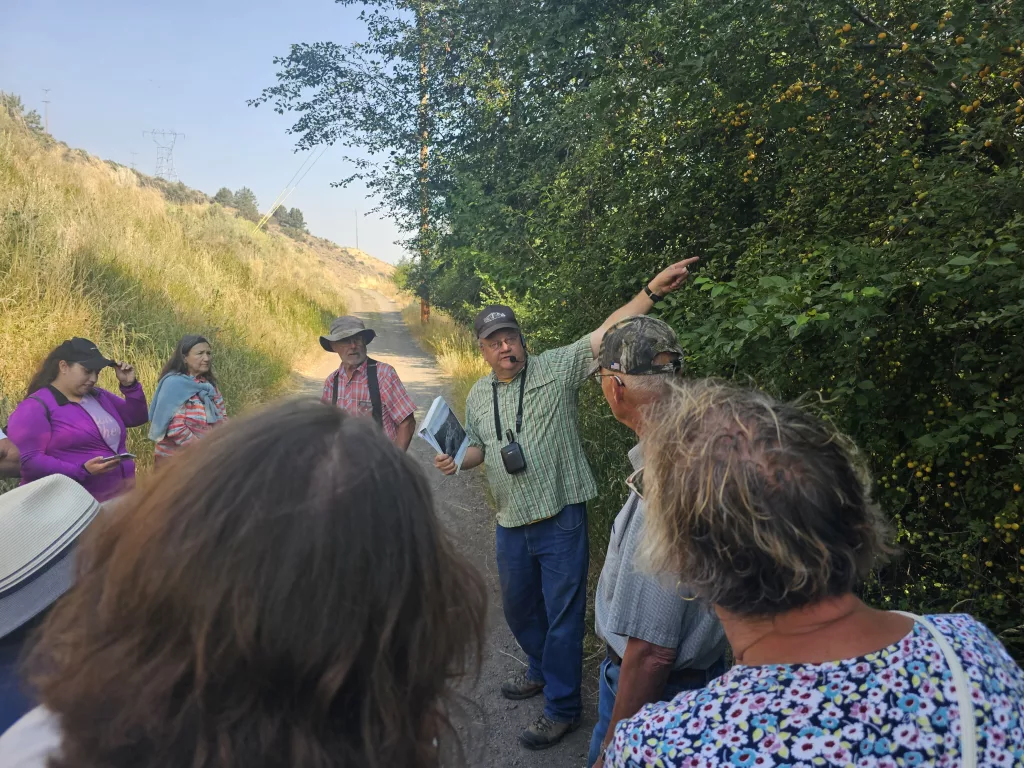Klamath Falls, Or- When Todd Kepple was a younger man, he welcomed guests to Klamath Falls for the Chamber of Commerce. The one question he had a tough time answering from visitors at the time was “Where are the Falls in Klamath Falls?” He was told to tell guests that the Falls were covered over by the dam that now sits high atop the rapids that gave name to the town over a century ago.
More than a few years later, Kepple, now the museum director at Klamath County Museum, has come to understand a different truth about the Falls that has plagued town leaders from the very start. The “falls” in Klamath Falls are not gone. Nor are they as grand as Niagara Falls or even Twin Falls. Klamath Falls falls are much more functional than the fiction that they were covered over but every bit as much a piece of Klamath Falls history.
On a guided walk on The Link River Trail Saturday, Kepple shared periodicals from the late 1800 and early 1900s. Despite the flowery language of a by-gone era of journalism, the message was the same in the 1890s as it was in the 1920s. City officials wanted to drop the name “Falls” from Klamath Falls citing a plain enough fact: They don’t look like the falls in towns with “Falls” in the name.
In the latter decades of the 19th and first half of the 20th century, town officials in the Chamber of Commerce wrestled with the idea that Klamath Falls used the name “falls” in the title. By 1920, a poll was offered in the Herald News asking residents to vote on whether the name “Falls” should be used in Klamath Falls. It is this historic hemming and hawing about the name that led to Kepple’s misinformation when he was a visitor guide for the Chamber of Commerce.
By the end of the mile and half walk, the 20 or so residents who joined Kepple for the walk understood the truth that Kepple has taken a lifetime to understand, The “falls” in Klamath Falls are the very reason this city is here, and the name boasts every bit of the power and ingenuity that towns of the 19-century, prior to combustion engines and megawatts of electric goodness, required, even if they don’t look like it.
The reason the “falls” in Klamath Falls look so different from it’s peers in Idaho and New York, is because it isn’t nearly as dramatic. While Niagara is just under 190 feet and Twin Falls is 200 feet, the span Klamath Falls drops is a mere 65 feet. And while the two other namesakes drop suddenly, Klamath Falls eases its way downstream over a half mile.
But as Kepple argues, Klamath has every right to claim the name “falls” , because it was those 65 feet of drop that played a critical role in technology, agriculture and manufacturing that played a pivotal role in the development of Klamath Falls as a city.
Kepple cited the journals of an explorer who wandered along the banks of The Link River who described the elevation decline from Upper Klamath Lake down to Lower Klamath Lake around 1893. The name was officially changed in 1893 from Linkville, thought to be too provincial for an up-and-coming community on the cusp of the 20th century to Klamath Falls, a much more fitting name. It was the promise the rushing water held for turning saw blades and grist mills and soon after spinning electric turbines and filling agricultural canals that inspired the name change.
Kepple says that it is the fact that some of the first western power generation of the last century was generated from the mighty rapids of Klamath Falls and much of the farming that built this town for the last 150 years was thanks to the 65 foot drop. Kepple said in an interview Saturday, “ When people see the name of our Town Klamath Falls, they come with the expectation that there is going to be someplace where they can go and see a nice beautiful waterfall, but that’s never what we had. It’s not like we lost the falls, or they got covered up. Our falls were more like a working set of falls. It was used to produce power to turn a sawmill blade, to grind grain, to divert water for irrigation on farms miles away and so our falls was a decline in elevation that allowed that kind of power generation to take place for the purposes of manufacturing and production and agriculture.”
The fact that there is no breathtaking vista from which to see crashing water falls however, did not take away from the lesson Kepple provided to tour goers Saturday. The trail lined with ripening fruit trees, and awe inspiring views of green hued rapids played perfect backdrop to the understanding Kepple offered to the attendees who freely admitted at the start of the day that they lacked any real knowledge of why Klamath Falls was called Klamath Falls.
And the bird watching, sound of rushing water and moderate hiking offered by the trail that meanders through history is more than enough to satiate any inquiring soul who might ask, “What do you mean there aren’t any waterfalls in Klamath Falls?”

